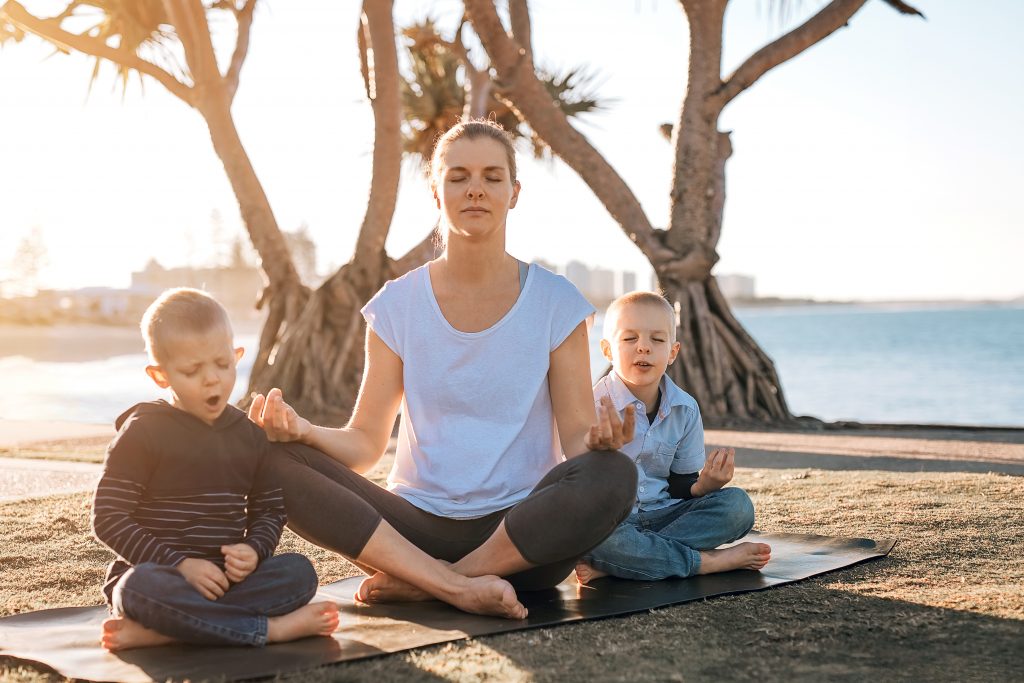How to incorporate mindfulness into your family’s life and increase wellbeing

What does mindfulness actually involve?
You’ve probably heard plenty of things about mindfulness, but do you really know what it entails?
Mindfulness is all about being present. When you’re being mindful, you’re totally in the zone and immersed in the present moment. You’re hugely aware of what you’re feeling and experiencing.
It sounds simple, right? But focusing your mind can be a massive challenge, especially when you can have thousands of thoughts in an average day.
There are so many myths about mindfulness. If you find yourself believing them, it be challenging to get the most from mindful activities.
One of the common myths is that you need to clear your mind totally to make it work. This is difficult (verging on impossible!) and can put you off trail. The truth is, mindfulness is about focusing on your body rather than trying to avoid thinking.
Any activity can become more mindful. The trick is to focus on what you can see, smell, taste, touch, or feel.
Let’s take the example of having a shower. Being mindful means you’re focused on things like the sound of the water, the feel of it on your skin, and the smell of your shower gel.
You can do mindfulness while you’re sitting down, standing up, or moving around. Technically, it is possible to practice mindfulness lying down but you may fall asleep!
Anyone can be mindful – it just takes some practice to make it a crucial part of your routine. If we look opportunities to be more mindful in your everyday life, it can start to become second nature quickly.
Why is mindfulness so important?
If you’re not familiar with mindfulness, you might wonder why it’s so popular and what it can do for you.
The effects of mindfulness have been well studied and the verdict is clear: being immersed in the present moment is beneficial for your wellbeing.
If you often find yourself caught up in your own thoughts, mindfulness can be your secret weapon for recognizing how they affect your behavior and emotions.
And it could be just what you need for breaking away from your thoughts and taking back control.
If you practice mindfulness regularly, you can see how your thoughts affect you in unhelpful ways.
You can take a step back from your thoughts and stop them from having so much power over you. Over time, you can train yourself to notice patterns in your thinking and break the ones that negatively affect you.
You can use mindfulness to bring your attention back to what you’re doing and what’s happening around you. This can stop anxiety in its tracks since you can quickly take control of your reaction to unhelpful thoughts.
The end result? Regular mindfulness can reduce stress, improve your focus and attention and help you feel calmer and in control.
It can have positive effects on your physical health too. Mindfulness can help lower your blood pressure and heart rate, reduce your perception of pain, keep your brain healthy, increase your immunity and improve your digestion.
Of course, children of all ages can benefit from mindfulness too. For our kids, this simple practice of bringing a gentle accepting attitude to the present moment is an amazing way to enhance their emotional intelligence. Mindfulness encourages self-regulation, impulse control, stronger understanding of emotions and ability to control emotions.
How to be more mindful every day
Whilst we know mindfulness is beneficial for emotional and physical health, you may have no clue how to start being more mindful if you’re new to the idea.
Mindfulness is not just about long formal meditation either. Here are some simple ways to include more mindfulness in your day:
- Pause every so often and reflect on the world around you. Take a few moments to just “be” and observe what’s going on. You might be surprised to see what you notice when you’re not going around on autopilot.
- Introduce meditation minutes at random intervals in the day.
- Be mindful while you’re waiting in line and bring your attention back to your breath.
- Check in with your body and take note of tension in your body, any aches and pains you can feel, and how you’re breathing. Connecting with your body like this can tell you a huge amount about your body that you might not be aware of otherwise have picked up on.
- Pay super close attention to how your food tastes and smells and focus all of your attention on your food. Mindful eating is a great one to practice if you usually eat while working, scrolling on your phone, or catching up on your favorite shows.
- Savor every sip of your first drink of the morning and tune into the smells and tastes.
- Go for a walk and focus on the sights and sounds around you. Take a few moments to appreciate the gorgeous flowers you see or the colors of the leaves. Listen to birdsong or the rustle of wind in the trees.
Fun ways to make your kids more mindful
Encouraging kids to be more mindful can help them manage stress and tune into their emotions from an early age. Who wouldn’t want to teach their kids this skill?
One of the mainstays of mindfulness is engaging the senses and kids are super good at this. But they’re not always so good at slowing down and being in the present moment.
Here are some fun activities that can help kids engage in mindfulness – even if they don’t realize they’re being mindful!
- Get your little one to do jumping jacks for a minute. When the time’s up, ask them to put their hand on their heart and tell you how their heart rate and breathing changes between physical activity and rest. This is a great exercise for getting them to tune into how their body feels.
- Explore your garden or a nearby green area and look for plants and rocks that may be hiding insects. When you find one, take a good look at any little creatures you find there. The golden rule here? Make sure you’re quiet on your travels so you can fully appreciate everything you see and hear.
- Create a Mindfulness jar. You’ll need a clean, empty jar or water bottle, clear glue, glitter, and food coloring. Fill it three-quarters full with water and add the other materials. Kids can shake the jar whenever stress or negative emotions crop up and watch the glitter settle which can be super comforting and helps their thoughts to settle too. This is one of the kids favourite activities during the Peaceful Kids program.
Mayhem to Mindful deliver the Peaceful Kids program, a meditation and mindfulness program for kids. The program helps children to build a brighter future by teaching lifelong skills to better deal with life’s stressors and worries.
Our Mindfulness and Positive Psychology based programs give children from Prep to Year 12 the skills, practice and support to utilise coping strategies that lessen the symptoms of anxiety and stress. It aims to give children lifelong skills for better mental health for long term into their teen and adult years.
Check out our program options at www.mayhemtomindful.com.au/peaceful-kids
Kasey x
